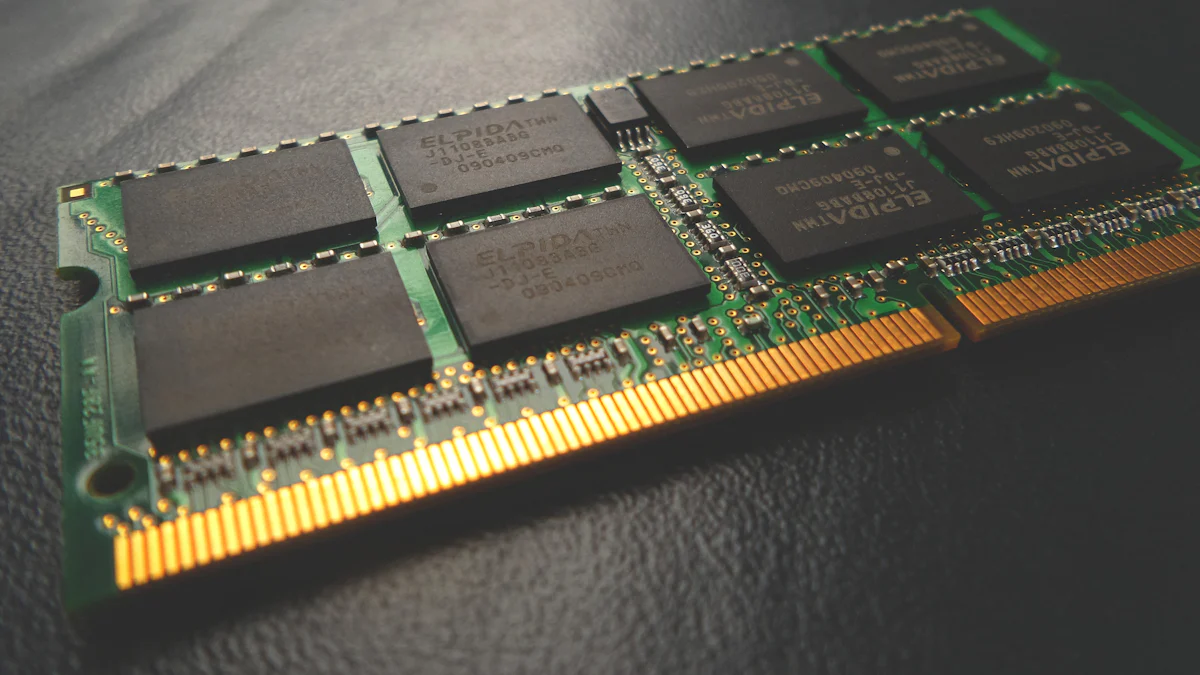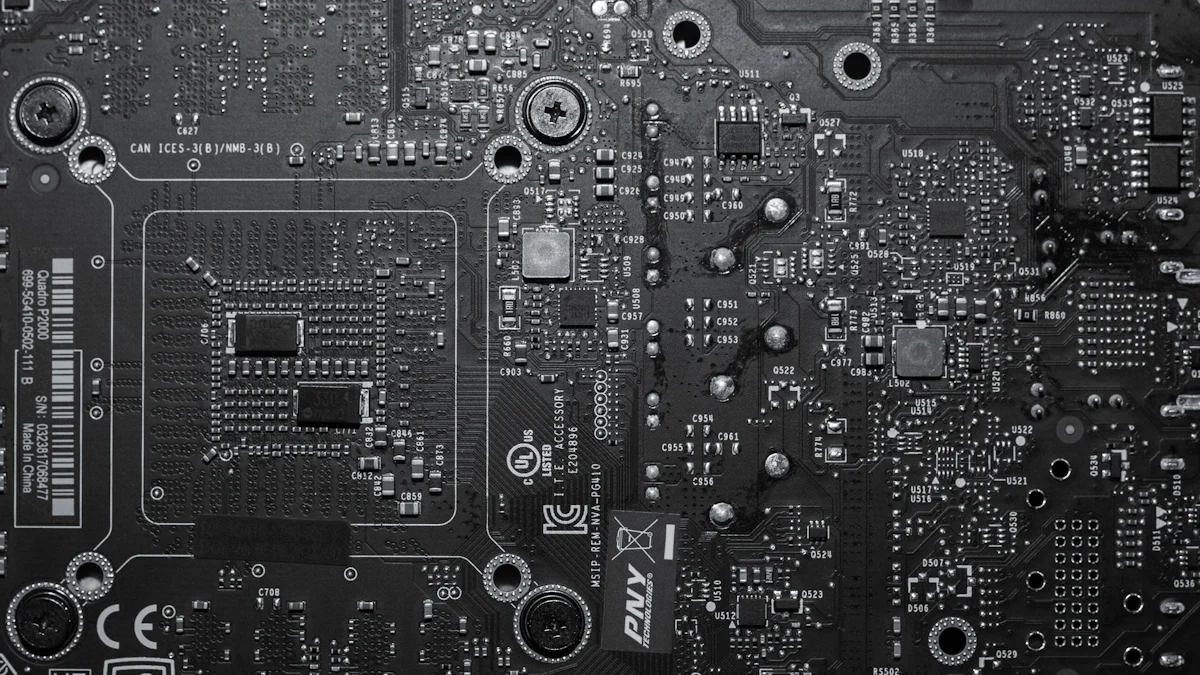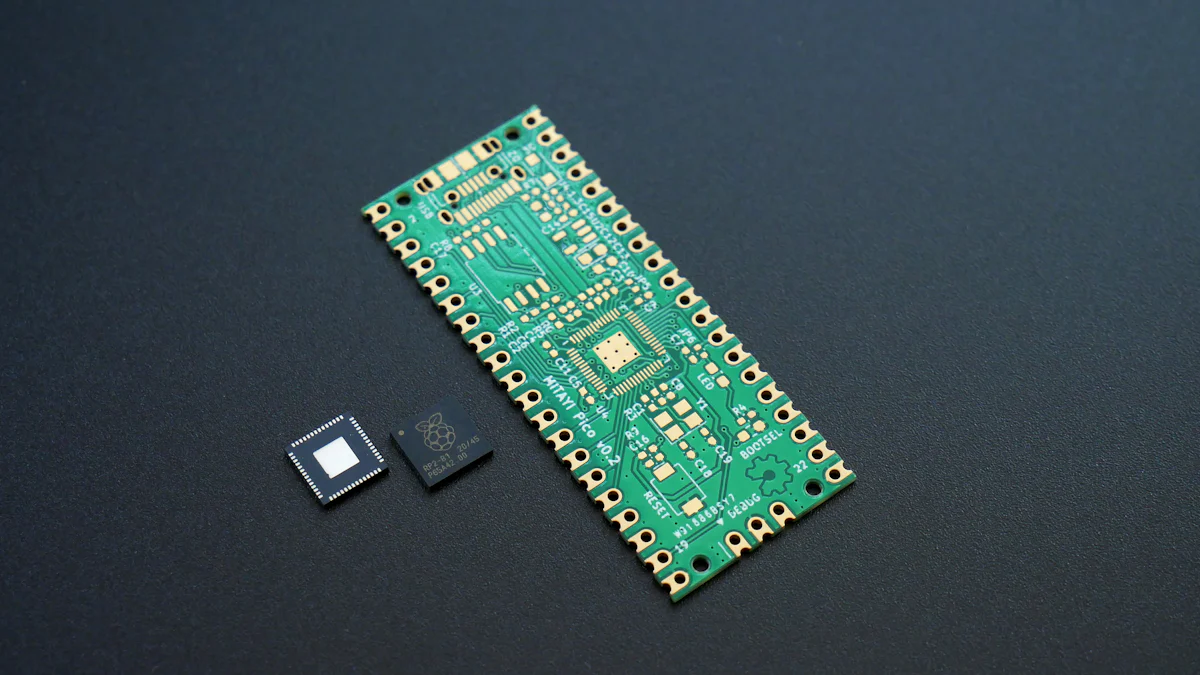
Les wafers en carbure de silicium se distinguent du silicium traditionnel par leurs performances supérieures et leurs applications variées. Ils offrent une plus grande conductivité thermique et peuvent fonctionner à des tensions élevées, ce qui les rend idéales pour les applications à haute puissance et à haute fréquence. Des industries comme les véhicules électriques, l'aérospatiale et les réseaux électriques comptent de plus en plus sur les plaquettes de carbure de silicium pour leur efficacité et leur durabilité. Le marché de ces wafers connaît une croissance rapide, avec des projections indiquant un taux de croissance annuel composé de 22.3% d'ici 2029. Cette poussée souligne l'importance croissante du carbure de silicium pour faire progresser l'efficacité électronique dans divers secteurs.
Principaux enseignements
- Les plaquettes de carbure de silicium offrent une conductivité thermique supérieure, permettant une dissipation de chaleur efficace dans les applications de haute puissance, ce qui les rend idéales pour les industries comme les véhicules électriques et l'aérospatiale.
- Avec un bandgap plus large que le silicium traditionnel, les wafers en carbure de silicium peuvent fonctionner à des tensions et températures plus élevées, améliorant l'efficacité et la fiabilité des appareils électroniques.
- La durabilité et la stabilité chimique des plaquettes de carbure de silicium assurent une durée de vie plus longue pour les appareils, réduisant les coûts d'entretien et les temps d'arrêt dans des environnements exigeants.
- Le carbure de silicium excelle dans l'efficacité énergétique, réduisant considérablement la perte d'énergie des appareils électroniques, ce qui est crucial pour le développement durable des technologies.
- Ces plaquettes sont particulièrement adaptées aux applications à haute tension, capables de manipuler des tensions jusqu'à dix fois plus élevées que le silicium traditionnel, ce qui les rend essentiels pour les réseaux électriques et les véhicules électriques.
- Malgré des coûts de fabrication plus élevés, les progrès technologiques rendent progressivement les wafers de carbure de silicium plus accessibles, avec un taux de croissance du marché prévu de 22,3% d'ici 2029.
- Les industries devraient tenir compte des avantages à long terme des plaquettes de carbure de silicium, tels que l'amélioration des performances et de l'efficacité énergétique, par rapport à l'investissement initial pour une sélection optimale des matériaux.
Propriétés du matériau des carbures de silicium

Physical Properties
Thermal Conductivity
Les plaquettes de carbure de silicium présentent une conductivité thermique exceptionnelle, qui dépasse de façon significative celle du silicium traditionnel. Cette propriété leur permet de dissiper efficacement la chaleur, ce qui les rend idéales pour les applications de haute puissance. Les dispositifs utilisant du carbure de silicium peuvent fonctionner à des températures plus élevées sans compromettre les performances. Cette capacité est essentielle dans les industries où la gestion thermique est une priorité, comme les véhicules électriques et l'aérospatiale.
Bandeau
Le bandgap de carbure de silicium est plus large que celui de silicium, offrant plusieurs avantages. Un bandgap plus large permet aux appareils de fonctionner à des tensions et températures plus élevées. Cette caractéristique améliore l'efficacité et la fiabilité des composants électroniques, en particulier dans les applications à haute fréquence. Le large bandgap contribue également à réduire les pertes d'énergie, ce qui est essentiel pour les appareils électroniques modernes qui cherchent l'efficacité énergétique.
Chemical Properties
Durabilité
Les plaquettes de carbure de silicium sont réputées pour leur durabilité. Ils possèdent une structure robuste qui résiste aux conditions environnementales difficiles, les rendant adaptés aux applications exigeantes. Cette durabilité assure une durée de vie plus longue pour les appareils, réduisant ainsi le besoin de remplacements et d'entretien fréquents. Les industries qui nécessitent des composants fiables et durables, tels que les réseaux électriques et les équipements industriels, bénéficient grandement de cette propriété.
Chemical Stability
La stabilité chimique du carbure de silicium est un autre avantage important. Il résiste aux réactions chimiques qui pourraient dégrader ses performances au fil du temps. Cette stabilité est particulièrement bénéfique dans les environnements exposés à des substances corrosives ou à des conditions extrêmes. Par conséquent, les wafers au carbure de silicium conservent leur intégrité et leur fonctionnalité, assurant ainsi une performance cohérente dans diverses applications.
Comparaison des performances des Wafers au carbure de silicium et du Silicone traditionnel
Efficacité
Efficacité énergétique
Les plaquettes en carbure de silicium excellent dans l'efficacité énergétique par rapport au silicium traditionnel. Leur large bande de 3,26 eV permet une vitesse de commutation plus rapide, ce qui améliore l'efficacité globale des appareils électroniques. Cette caractéristique permet de créer des appareils plus petits et plus efficaces qui consomment moins d'énergie. Dans les applications de haute puissance, les plaquettes de carbure de silicium réduisent considérablement la perte d'énergie, ce qui en fait un choix privilégié pour les industries visant à optimiser la consommation d'énergie.
Perte d'énergie
La perte d'énergie dans les appareils électroniques résulte souvent d'une gestion de la chaleur inefficace et d'une résistance électrique. Les plaquettes de carbure de silicium s'attaquent à ces problèmes avec leur conductivité thermique supérieure et une résistance ON plus faible. Ces propriétés réduisent la dissipation d'énergie en tant que chaleur, assurant ainsi un fonctionnement plus efficace des appareils. En réduisant la perte d'énergie, les plaquettes de carbure de silicium contribuent au développement de technologies durables qui privilégient les économies d'énergie.
Maintenance
Applications haute tension
Les plaquettes de carbure de silicium présentent des performances remarquables dans les applications à haute tension. Ils peuvent supporter des tensions jusqu'à dix fois plus élevées que le silicium traditionnel, ce qui les rend idéales pour la conversion de puissance et les systèmes de distribution. Cette capacité est cruciale pour des industries telles que les véhicules électriques et les réseaux électriques, où la manutention à haute tension est essentielle pour un fonctionnement et une sécurité efficaces.
Capacité actuelle
La capacité actuelle des wafers de carbure de silicium dépasse celle du silicium traditionnel en raison de leur plus grande résistance au champ électrique. Cet attribut permet aux appareils de gérer des courants plus importants sans compromettre les performances. Par conséquent, les wafers en carbure de silicium sont bien adaptés pour les applications nécessitant une manipulation robuste de la puissance, comme les équipements industriels et l'électronique de haute puissance.
Tolérance à la température
Performance à haute température
Les plaquettes de carbure de silicium présentent des performances exceptionnelles à haute température, un facteur critique dans de nombreuses applications industrielles. Leur capacité à fonctionner à des températures élevées sans dégradation assure fiabilité et longévité dans des environnements exigeants. Cela les rend particulièrement utiles dans des secteurs comme l'aérospatiale et l'automobile, où les composants doivent supporter des conditions extrêmes.
Gestion thermique
Une gestion thermique efficace est essentielle pour maintenir les performances du dispositif et prévenir les fuites thermiques. Les plaquettes de carbure de silicone offrent une conductivité thermique supérieure, ce qui facilite une dissipation de chaleur efficace. Cette propriété élimine souvent le besoin de systèmes de refroidissement supplémentaires, réduisant à la fois la complexité et le coût de la conception des appareils. Les industries profitent de cet avantage en obtenant des solutions plus compactes et rentables.
Applications de carbure de silicium Wafers

Environnements à haute puissance
Véhicules électriques
Les plaquettes de carbure de silicium ont révolutionné l'industrie des véhicules électriques (EV). Leur capacité à gérer des tensions et des températures plus élevées les rend idéales pour l'électronique de puissance EV. Carbure de silicium permet une conversion d'énergie efficace dans les convertisseurs DC/DC embarqués et les chargeurs rapides DC hors-bord. Ces wafers améliorent également les performances des chargeurs de batterie embarqués et des groupes motopropulseurs EV. Les systèmes d'éclairage automobile, en particulier les LED, bénéficient de propriétés supérieures de carbure de silicium. En réduisant la perte d'énergie et en améliorant la densité de puissance, les gaufres au carbure de silicium contribuent à prolonger les plages de conduite et à accélérer les temps de charge des véhicules électriques.
Grilles électriques
Les réseaux électriques nécessitent des composants capables de gérer efficacement les hautes tensions et les courants. Les plaquettes de carbure de silicium excellent dans ces applications en raison de leur forte résistance au champ électrique. Ils améliorent l'efficacité et la fiabilité des systèmes de conversion et de distribution de puissance. La conductivité thermique du carbure de silicium assure une dissipation thermique efficace, réduisant ainsi le risque de surchauffe des composants du réseau électrique. Cette capacité favorise l'intégration des sources d'énergie renouvelables, comme l'énergie solaire et éolienne, dans le réseau. En améliorant les performances des réseaux électriques, les plaquettes de carbure de silicium jouent un rôle crucial dans la promotion de solutions énergétiques durables.
High-Temperature Environments
Aérospatiale
L'industrie aérospatiale exige des matériaux qui peuvent résister à des conditions extrêmes. Les plaquettes de carbure de silicium répondent à cette exigence avec leurs performances exceptionnelles à haute température. Ils maintiennent la stabilité et la fonctionnalité dans les applications aérospatiales, où les composants font face à une chaleur et une pression intenses. La durabilité du carbure de silicium assure la longévité des systèmes électroniques dans les aéronefs et les engins spatiaux. Sa capacité à fonctionner à des températures élevées sans dégradation améliore la fiabilité des composants aérospatiales critiques. En assurant une gestion thermique efficace, les wafers de carbure de silicium contribuent à des technologies aérospatiales plus sûres et plus efficaces.
Matériel industriel
L'équipement industriel fonctionne souvent dans des environnements difficiles, nécessitant des matériaux qui peuvent supporter des températures élevées et des contraintes mécaniques. Les plaquettes de carbure de silicium offrent la durabilité et la stabilité thermique nécessaires pour ces applications. Ils améliorent l'efficacité des moteurs industriels et des systèmes CVC en réduisant les pertes d'énergie et en améliorant les capacités de manutention. La stabilité chimique du carbure de silicium assure une résistance aux substances corrosives, ce qui le rend adapté pour une utilisation dans des environnements industriels difficiles. En prolongeant la durée de vie des équipements industriels, les plaquettes de carbure de silicium réduisent les coûts d'entretien et les temps d'arrêt, ce qui contribue à accroître la productivité.
Coût et disponibilité des Wafers au carbure de silicium
Cost Implications
Coûts de fabrication
Les wafers en carbure de silicium, tout en offrant des performances supérieures, offrent des coûts de fabrication plus élevés que le silicium traditionnel. Le processus de production du carbure de silicium implique des techniques plus complexes et plus précises, qui contribuent à l'augmentation des coûts. Malgré ces dépenses initiales plus élevées, les progrès technologiques et les économies d'échelle réduisent progressivement ces coûts. Par exemple, la variante de carbure de silicium 4H est moins chère à fabriquer que son homologue 6H, bien que les deux restent plus chers que le silicium traditionnel.
Prix du marché
La tarification sur le marché des plaquettes de carbure de silicium reflète leurs capacités avancées et les coûts associés à leur production. Toutefois, une tendance à la baisse des prix a été observée en raison des progrès technologiques et de l'augmentation des volumes de production. Cette tendance devrait se poursuivre, rendant les plaquettes de carbure de silicium plus accessibles à un plus large éventail d'industries. Le marché mondial des wafers de carbure de silicium devrait croître considérablement, atteignant USD 4 385 550,41 Mille avant 2029, avec un taux de croissance annuel composé (TCAC) 22.3% de 2022 à 2029. Cette croissance indique un avenir prometteur pour le carbure de silicium dans diverses applications.
Disponibilité
Considérations relatives à la chaîne d'approvisionnement
La disponibilité de plaquettes de carbure de silicium dépend fortement de la dynamique de la chaîne d'approvisionnement. Les taux de rendement, souvent confidentiels au sein de l'industrie, jouent un rôle crucial dans la détermination de l'offre. La plupart des prévisions estiment l'offre en fonction de la capacité de la plaque signalétique, qui peut varier considérablement d'un fabricant à l'autre. À mesure que la demande de carbure de silicium augmente, les entreprises investissent dans l'expansion de leurs capacités de production pour assurer un approvisionnement régulier. Cette expansion est essentielle pour répondre aux besoins croissants des industries telles que les véhicules électriques et les réseaux électriques.
Tendances du marché
Les tendances du marché indiquent une trajectoire de croissance robuste pour les wafers de carbure de silicium. La taille du marché a été évaluée à 742,7 millions de dollars en 2023 et devrait atteindre 2 019,4 millions de dollars d'ici 2030, en croissance à un TCAC de 20.3% pendant la période de prévision de 2024 à 2030. Cette croissance est due à l'adoption croissante de carbure de silicium dans les applications à haute tension et à haute température. Comme de plus en plus d'industries reconnaissent les avantages du carbure de silicium, la demande devrait augmenter, ce qui influera davantage sur les tendances du marché et la disponibilité.
Les plaquettes de carbure de silicium offrent plusieurs avantages par rapport au silicium traditionnel, en particulier dans les applications de haute puissance. Ils excellent dans la manipulation des hautes tensions, des hautes températures, et des courants élevés en raison de leur conductivité thermique supérieure et large bande. Ces propriétés les rendent idéales pour les industries nécessitant une gestion efficace de l'énergie et la durabilité. Toutefois, l'augmentation du coût en capital demeure une considération pour les adoptants potentiels. Lors de la sélection des matériaux, les industries devraient évaluer ces avantages par rapport à l'investissement initial. Pour les applications exigeant des performances et une fiabilité élevées, le carbure de silicium offre un choix convaincant, assurant une efficacité à long terme et des pertes d'énergie réduites.
FAQ
Qu'est-ce qu'une galette de carbure de silicium typique?
Un wafer de carbure de silicium (SiC) sert de matériau semi-conducteur composé de silicium et de carbone. Les fabricants créent ces wafers par gravure au carbure de silicium cristallin, ce qui donne un matériau mince adapté aux dispositifs à semi-conducteurs. Les wafers SiC présentent une conductivité dans les deux sens, ce qui les rend polyvalents pour diverses applications. Leur capacité à fonctionner sur une large plage de température s'avère cruciale pour la gestion des champs électriques et magnétiques des semi-conducteurs électriques.
Comment le carbure de silicium se compare-t-il au silicium traditionnel en termes de conductivité thermique?
Le carbure de silicium surpasse significativement le silicium traditionnel dans la conductivité thermique. Cette propriété supérieure permet aux wafers SiC de dissiper efficacement la chaleur, qui est essentielle pour les applications de haute puissance. Les dispositifs utilisant du carbure de silicium peuvent maintenir des performances à des températures plus élevées, réduisant le risque de surchauffe et améliorant la fiabilité.
Pourquoi le bandgap de carbure de silicium est-il important ?
La bande plus large de carbure de silicium, par rapport au silicium traditionnel, offre plusieurs avantages. Il permet aux appareils de fonctionner à des tensions et températures plus élevées, en améliorant l'efficacité et la fiabilité. Cette caractéristique réduit également la perte d'énergie, qui est vitale pour les appareils électroniques modernes qui s'efforcent d'atteindre l'efficacité énergétique.
Quelles industries bénéficient le plus des wafers au carbure de silicium?
Des industries telles que les véhicules électriques, l'aérospatiale et les réseaux électriques bénéficient grandement des wafers au carbure de silicium. Ces secteurs nécessitent des matériaux capables de gérer efficacement les hautes tensions, les températures et les courants. Les propriétés supérieures de carbure de silicone le rendent idéal pour les applications exigeant une gestion robuste de la puissance et la durabilité.
Les wafers au carbure de silicium sont-ils plus chers que le silicium traditionnel?
Oui, les wafers de carbure de silicium entraînent généralement des coûts de fabrication plus élevés que le silicium traditionnel en raison des processus de production complexes en cause. Toutefois, les progrès technologiques et les économies d'échelle réduisent progressivement ces coûts, ce qui rend les triages SiC plus accessibles à un plus large éventail d'industries.
Comment les plaquettes de carbure de silicium contribuent-elles à l'efficacité énergétique?
Les plaquettes de carbure de silicium améliorent l'efficacité énergétique grâce à leur large bande et à leur conductivité thermique supérieure. Ces propriétés permettent d'accélérer les vitesses de commutation et de réduire la perte d'énergie, permettant la création de dispositifs plus petits et plus efficaces qui consomment moins d'énergie. Cette efficacité est particulièrement bénéfique dans les applications de haute puissance.
Quelles sont les considérations de la chaîne d'approvisionnement pour les plaquettes de carbure de silicium?
La disponibilité des plaquettes de carbure de silicium dépend fortement de la dynamique de la chaîne d'approvisionnement, y compris les taux de rendement et les capacités de production. À mesure que la demande augmente, les fabricants investissent dans l'expansion de leurs capacités de production pour assurer un approvisionnement régulier, en particulier pour les industries comme les véhicules électriques et les réseaux électriques.
Comment les plaquettes de carbure de silicium fonctionnent-elles dans des environnements à haute température?
Les plaquettes de carbure de silicium excellent dans les environnements à haute température en raison de leur stabilité thermique exceptionnelle. Ils maintiennent des performances sans dégradation, assurant fiabilité et longévité dans des conditions exigeantes. Cela les rend utiles dans des secteurs comme l'aérospatiale et l'automobile, où les composants doivent supporter des températures extrêmes.
Quel rôle jouent les plaquettes de carbure de silicium dans les réseaux électriques?
Dans les réseaux électriques, les plaquettes de carbure de silicium améliorent l'efficacité et la fiabilité en manipulant efficacement les hautes tensions et les courants. Leur résistance élevée au champ électrique et leur conductivité thermique favorisent une conversion et une distribution efficaces de l'énergie, facilitant ainsi l'intégration des sources d'énergie renouvelables dans le réseau.
Comment le marché des wafers de carbure de silicium se présente-t-il à l'avenir?
Le marché des wafers de carbure de silicium devrait croître de façon significative, en raison de l'adoption croissante dans les applications à haute tension et à haute température. Comme un plus grand nombre d'industries reconnaissent les avantages de SiC, la demande devrait augmenter, ce qui aura une incidence positive sur les tendances du marché et la disponibilité.